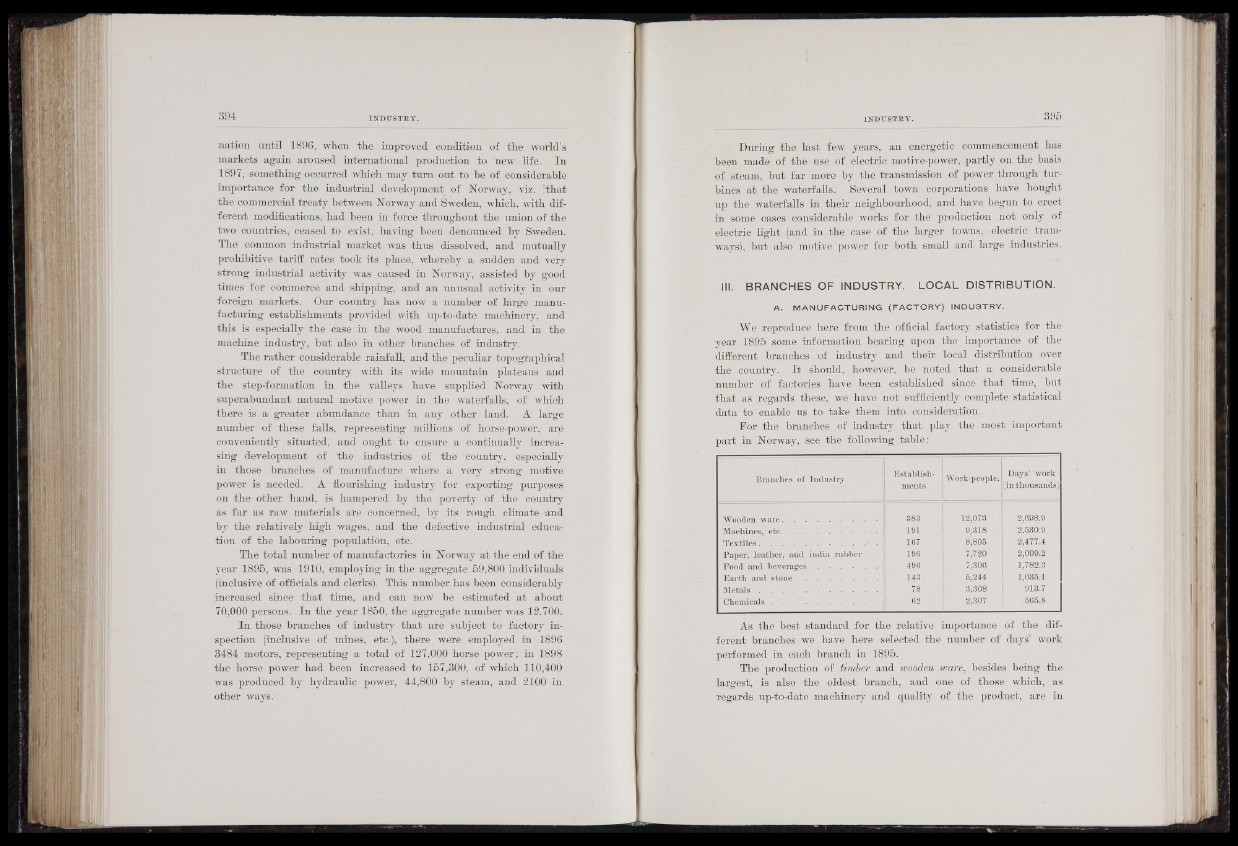
nation until 1896, wlien the improved condition of the world’s
markets again aroused international production to new life. In
1897, something occurred which may turn out to be of considerable
importance for the industrial development^ of Norway, viz. Ithat
the commercial treaty between Norway and Sweden, which, with different
modifications, had been in force throughout the union of the
two countries, ceased to exist, having been denounced by Sweden.
The common industrial market was thus dissolved, and mutually
prohibitive tariff rates took its place, whereby à sudden and very
strong industrial activity was caused in Norway, assisted by good
times for commerce and shipping, and an unusual activity in our
foreign markets. Our country has now a number of large manufacturing
establishments provided with up-to-date machinery, and
this is especially the case in the wood manufactures, and in the
machine industry, but also in other branches of industry.
The rather considerable rainfall, and the peculiar topographical
structure of the country with its wide mountain plateaus and
the step-formation in the valleys have supplied Norway with
superabundant natural motive power in the waterfalls, of which
there is a greater abundance than in any other land. A large
number of these falls, representing millions of horse-power, are
conveniently situated, and ought to ensure a continually increasing
development of the industries of the country, especially
in those branches of manufacture where a very strong motive
power is needed. A flourishing industry for exporting purposes
on the other hand, is hampered by the poverty of the country
as far as raw materials are concerned, by its rough climate and
by the relatively high wages, and the defective industrial education
of the labouring population, etc.
The total number of manufactories in Norway at the end of the
year 1895, was 1910, employing in the aggregate 59,800 individuals
(inclusive of officials and clerks). This number has been considerably
increased since that time, and can now be estimated at about
70,000 persons. In the year 1850, the aggregate number was 12,700.
In those branches of industry that are subject to factory inspection
(inclusive of mines, etc.), there were employed in 1896
3484 motors, representing a total of 127,000 horse power; in 1898
the horse power had been increased to 157,300, of which 110,400
was produced by hydraulic power, 44,800 by steam, and 2100 in
other ways.
■ During the last few years, an energetic commencement has
been made of the use of electric motive-power, partly on the basis
of steam, but far more by the transmission of power through turbines
at the waterfalls. Several town corporations have bought
up the waterfalls in their neighbourhood, and have begun to erect
in some cases considerable works for the production not only of
electric light (and in the case of the larger towns, electric tramways),
but also motive power for both small and large industries.
III. BRANCHES OF INDUSTRY. LOCAL DISTRIBUTION.
A. MANUFACTURING (FACTORY) INDUSTRY.
We reproduce here from the official factory statistics for the
year 1895 some information bearing upon the importance of the
different branches of industry and their local distribution over
the country. I t should, however, be. noted that a considerable
'number of factories have been established since that time, but
that as regards these; we have not sufficiently complete statistical
data to enable us to take them into consideration.
For the branches of industry that play the most important
part in Norway, see the following table:
Branches of Industry Establishments
Work-people. Days’ work
(in thousands)
Wooden ware. . . .. . . . - . . 388 . 12,078 2,698.9
Machines, etc. . '. ........................... 191 9,318 '2,530.9
Textiles............................... ..... I ■ * • 167 8,805 2,477:4
Paper, leather, and india ru b b e r. . 196 7,720 2,099.2
Food and b e v e r a g e s .......................... 496 7,306 1,782.3
Earth and stone. . ........................... 143 5,244 . 1,035.1
Metals . . . . . . • ■ . • 78 3,308' 913,7
Chemicals .......................................... . • 62 2,307 6Ç5.8
As the best standard for the relative importance of the different
branches we have here selected the number of days’ work
performed in each branch in 1895.
The production of timber, and wooden ware, besides being the
largest, is also the oldest branch, and one of those which, as
regards up-to-date machinery and quality of the product, are in